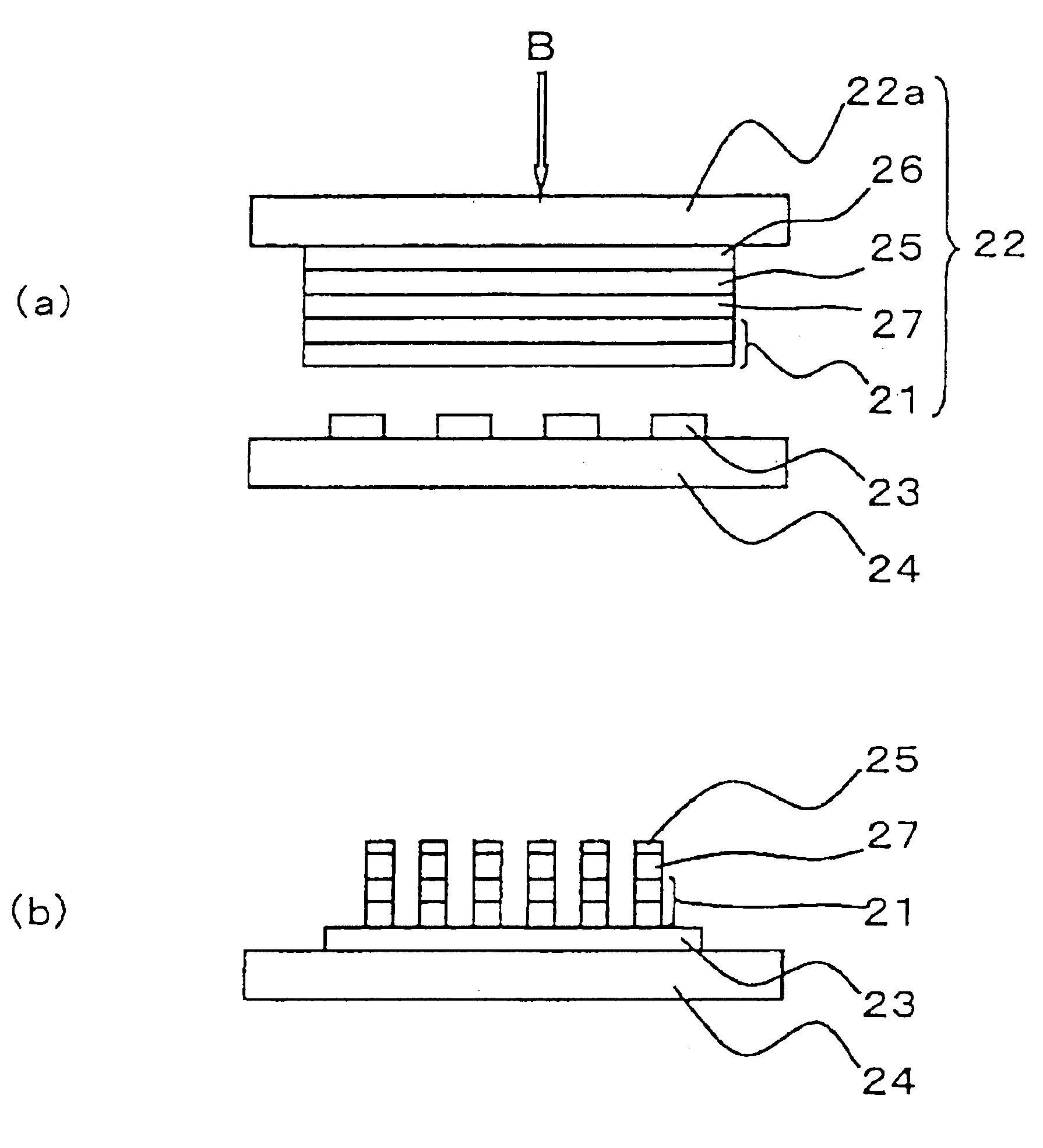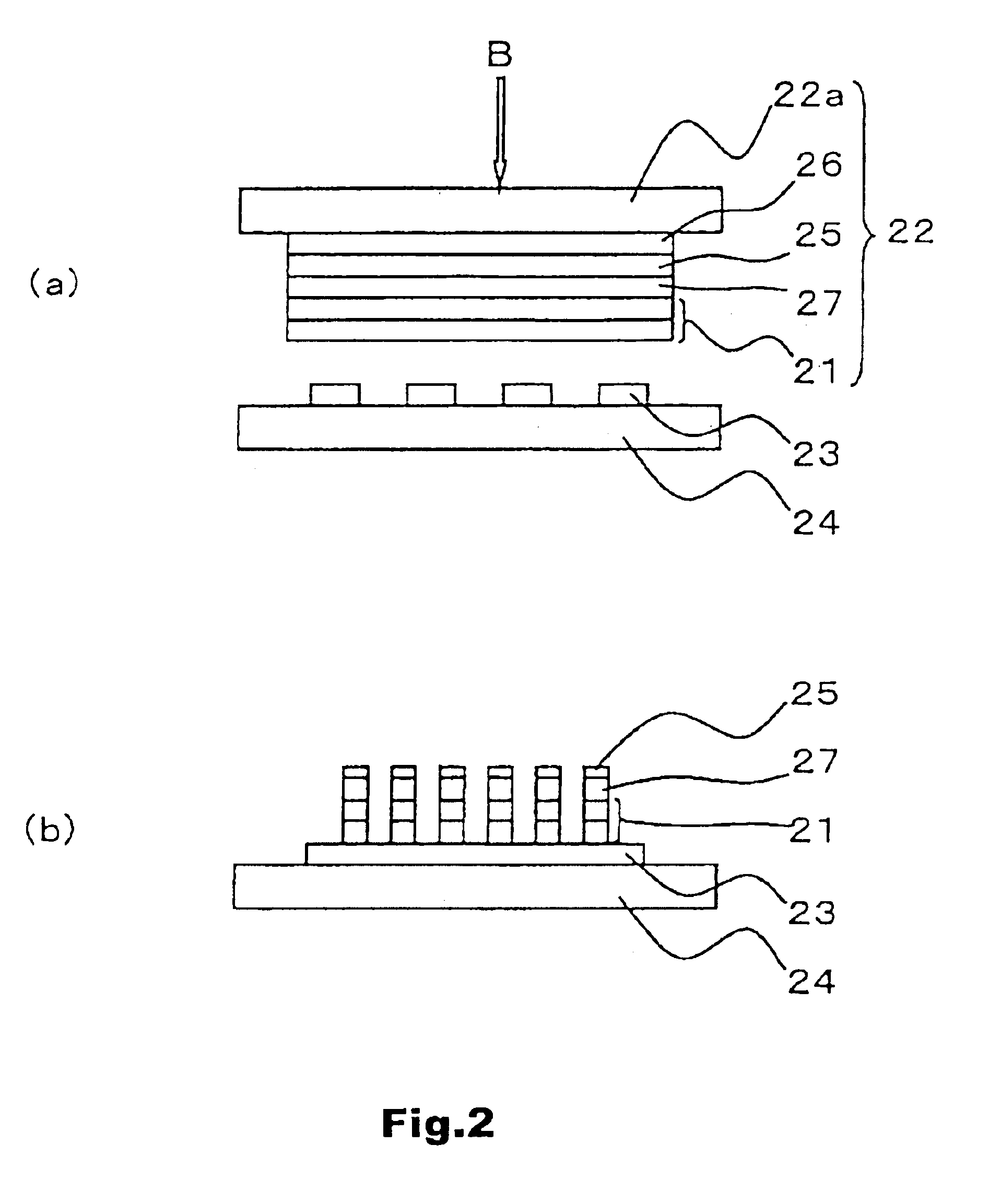Transfer film and process for producing organic electroluminescent device using the same
a technology of transfer film and electroluminescent device, which is applied in the manufacture of electromechanical devices, photographic processes, electric lighting sources, etc., can solve the problems of difficult pattern formation, easy damage to organic materials composing organic electromechanical devices, corrosion or degradation
- Summary
- Abstract
- Description
- Claims
- Application Information
AI Technical Summary
Problems solved by technology
Method used
Image
Examples
example 1
Polyethylene terephthalate with a thickness of 150 .mu.m was used as a base film. Formed thereon was a layer of stearic acid with a thickness of 100 nm by a vapor-deposition method as a transfer auxiliary layer. The melting point of stearic acid was 68.degree. C. Further, (8-hydroxyquinolinato) aluminum complex (Alq.sub.3) (melting point: 413.degree. C., glass transition temperature: 175.degree. C.) serving as the organic light-emitting layer and N,N'-di(naphthalene-1-yl)-N,N'-diphenyl-bendizine (NPD) (melting point: 275.degree. C., glass transition temperature: 95.degree. C.) serving as the hole transporting material were formed by the vapor-deposition method, each having a thickness of 50 nm. The transfer film thus manufactured was attached to a glass substrate that was patterned in advance to have a transparent electrode formed thereon. A linear heat source (e.g., nichrome line through which electric current flows) was pushed to the resultant from the base film side for fusing th...
example 2
A transfer was performed by the same manner as in the Example 1 except that any one of a multi-layer film of Al layer / Alq.sub.3 layer / NPD layer, a multi-layer film of light transmitting metal thin-film Al layer / Alq.sub.3 layer / NPD layer and a multi-layer film of transparent conductive layer / NPD layer / Alq.sub.3 layer was used for the transfer layer. A satisfactory transfer could also be obtained. Transferring simultaneously an electrode layer enabled reduction in the number of process.
Generally, materials used for the electrode layer are inorganic and have a greater hardness than organic materials. Therefore, their thickness is preferably thin in order to perform a satisfactory transfer. Moreover, the structure of the multi-layer film of metal thin-film Al layer / Alq.sub.3 layer / NPD layer or the multi-layer film of transparent conductive film layer / NPD layer / Alq.sub.3 layer enables to take the emission from the side opposite to the substrate, whereby the decrease of aperture ratio can...
example 3
Polyethylene terephthalate with a thickness of 150 .mu.m was used as a base film. Formed thereon as a light-to-heat conversion layer was a layer in which carbon black was dispersed in a polymer material. The transfer auxiliary layer, hole transporting layer and light-emitting layer were formed by the same manner as in Example 1. The transfer film thus manufactured was attached to a glass substrate that was patterned in advance to have a transparent electrode formed thereon. Laser light was irradiated to the resultant from the base film side for fusing the transfer auxiliary layer by utilizing the heat at the light-to-heat conversion layer, whereby the transfer layer was pattern-transferred onto the glass substrate having the transparent electrode formed thereon. Power of the laser light was optionally selected to thereby obtain a satisfactory transfer layer. A cathode was formed after the transfer on the transfer layer, with the result that a green light emission from Alq.sub.3 was ...
PUM
| Property | Measurement | Unit |
|---|---|---|
| thickness | aaaaa | aaaaa |
| thickness | aaaaa | aaaaa |
| thickness | aaaaa | aaaaa |
Abstract
Description
Claims
Application Information
 Login to View More
Login to View More - R&D
- Intellectual Property
- Life Sciences
- Materials
- Tech Scout
- Unparalleled Data Quality
- Higher Quality Content
- 60% Fewer Hallucinations
Browse by: Latest US Patents, China's latest patents, Technical Efficacy Thesaurus, Application Domain, Technology Topic, Popular Technical Reports.
© 2025 PatSnap. All rights reserved.Legal|Privacy policy|Modern Slavery Act Transparency Statement|Sitemap|About US| Contact US: help@patsnap.com



